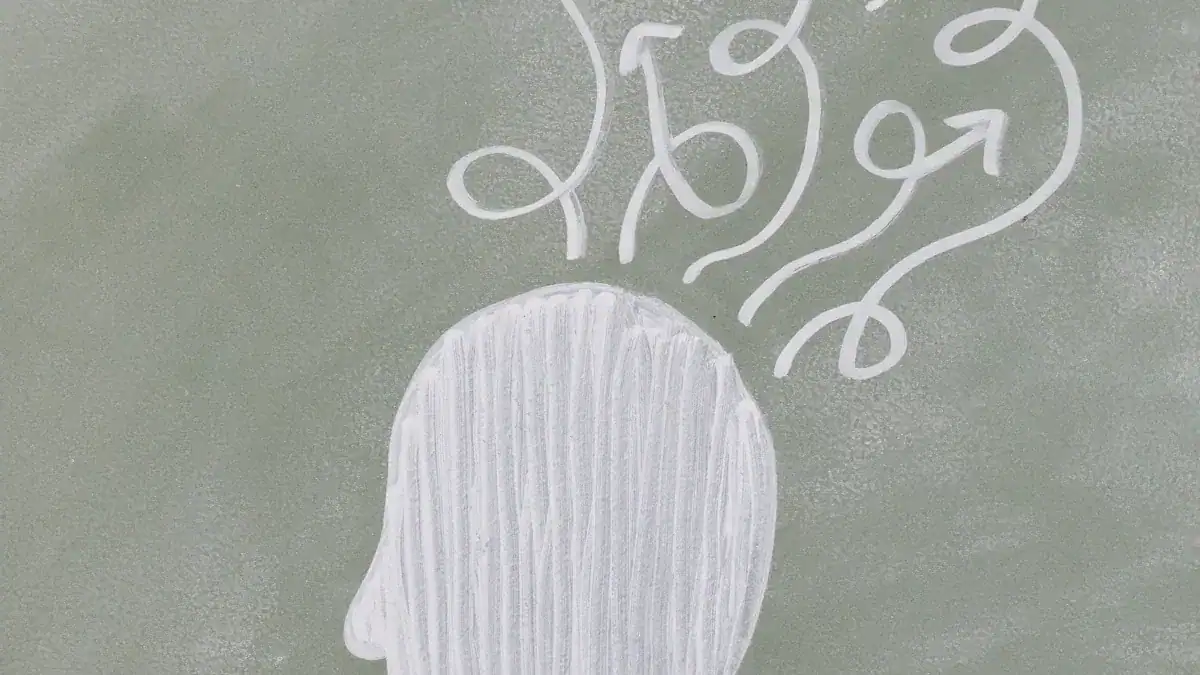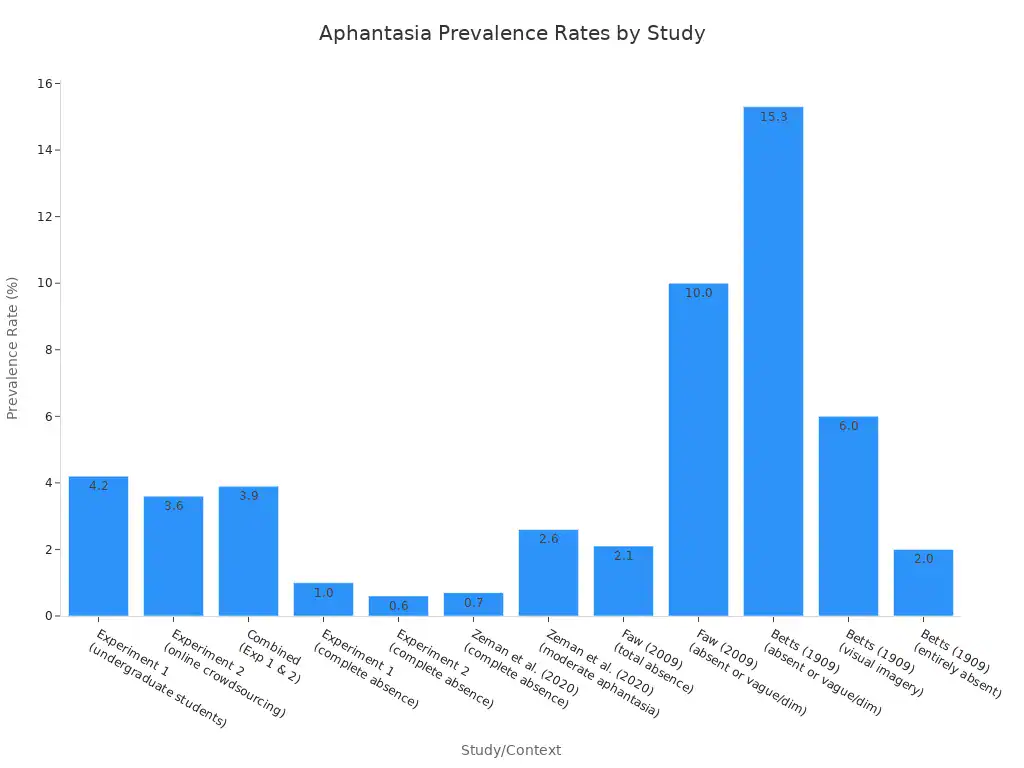
Close your eyes and imagine an apple. What do you see? Do you clearly see its red skin, its round shape, or even feel its texture in your mind? Or do you see nothing, just darkness or vague impressions?
This difference points to aphantasia, the inability to visualize. It means you cannot form mental images. Could you have aphantasia? This aphantasia test explores your capacity for visual imagery and helps you understand your own mental images.
Key Takeaways
- Aphantasia means you cannot see pictures in your mind. You know facts about things, but you do not form mental images.
- You can test for aphantasia with simple exercises, like trying to imagine an apple, or by taking a detailed quiz like the VVIQ.
- Aphantasia is a normal way your brain works, not a problem. It affects about 1 to 5 people out of 100.
- People with aphantasia often have strong skills in thinking about ideas and solving problems. They find different ways to be creative.
- Your memory and dreams might work differently with aphantasia. You may still have vivid dreams even if you cannot visualize when awake.
What Is Aphantasia

Defining the Mind’s Eye
Most people can close their eyes and see things in their head. This ability is often called your “mind’s eye.” You can picture a friend’s face, a favorite place, or even a purple elephant. You create these pictures using your brain. This process is called forming mental images.
For many, these mental images are clear and vivid. They can see colors, shapes, and details.
However, some people do not experience this. If you have aphantasia, you cannot produce mental images. When you try to picture something, your mind remains blank. You might understand the concept of an apple, but you do not “see” an apple in your head. You know facts about it, like its color or shape, but no visual imagery appears.
For example, you might recall your mother has brown hair and a kind smile. You recognize her instantly when you see her. But you cannot form a mental picture of her face in your mind. This way of experiencing the world often leads to strengths in abstract thinking. You might excel at logical reasoning and understanding complex ideas. Your memory often focuses on facts and lists rather than visual scenes.
The Visualization Spectrum
Thinking about visualization is not a simple yes or no question. It is more like a spectrum, a wide range of abilities. On one end, you have aphantasia, where you experience no visual imagery. On the other end, some people have hyperphantasia. They experience extremely vivid and detailed mental images. Most people fall somewhere in the middle.
You can think of different levels of visualization. At a basic level, you might visualize things you have seen before. You can recall a book page or a simple 2D shape. At an advanced level, you might change things you have seen. You can rearrange book pages or imagine new designs. Expert visualizers can picture things they have never seen. They can imagine complex energy fields. Master visualizers can picture almost anything, even fundamental forces or different dimensions.
People also visualize in different ways. Some excel at spatial-mechanical visualization. They can picture how gears fit together. Others are good at numerical-pattern visualization.
They see patterns in numbers. Some can create photo-realistic object visualization. They see objects as clearly as a photograph. Others use creative or intuitive visualization. They imagine new ideas and concepts. This shows that your ability to create imagery is unique.
Common Misconceptions
Many misunderstandings exist about aphantasia. Some people think aphantasia means you lack imagination or creativity. This is not true. People with aphantasia often express creativity through words, concepts, or hands-on work.
For example, one person might enjoy writing and bending grammar rules. Another might learn macramé by creating new knot combinations. Your mind works differently, but it is still very active and creative.
Another common mistake is thinking aphantasia is a “superpower” that lets you avoid bad memories. While you might not see gruesome images in your head, the emotional impact and the idea of the image can still cause distress. Also, people often misunderstand common phrases.
When someone says “count sheep,” they usually mean to visualize sheep jumping over a fence. For someone with aphantasia, “counting sheep” might just mean focusing on the idea of sheep to fall asleep.
You might also hear about memory techniques like a “mental palace.” This technique relies heavily on visualization. People with aphantasia cannot use it in the same way. They might use a conceptual version instead.
It is also wrong to assume that if you have aphantasia, you cannot maintain a thought process or play a song in your head. You can, but you might not “hear” the song in the same way others do. You might need to hum it to yourself. It is important to remember that aphantasia is a variation in how your brain works, not a flaw. It is simply a different way your mind processes information. This aphantasia test helps you understand your unique cognitive style.
Aphantasia Test: Self-Assessment

You can explore your own ability to visualize with some simple tests. These tests help you understand your unique mental experience. They give you clues about your “mind’s eye.”
Simple Test for Aphantasia: The Apple
Let’s try a quick aphantasia test. Close your eyes for a moment. Now, try to imagine a bright red apple. Can you see its color? Can you see its round shape? Do you see a stem? Perhaps you can even imagine a small leaf attached.
Now, try to visualize a red star. Can you see its sharp points? Is it a clear, vivid image in your mind? Or do you see nothing at all? Maybe you only have a vague idea of what an apple or a star looks like. If your mind remains blank, you might have aphantasia. This simple test for aphantasia gives you a first hint.
VVIQ Quiz: Detailed Assessment
For a more detailed look, you can use the Vividness of Visual Imagery Questionnaire (VVIQ). British psychologist David Marks created this quiz in 1973. Its purpose is to explore the vividness of your visual imagination.
The VVIQ is a widely used quiz. It helps identify people with aphantasia or those with very low visual imagery vividness. Low scores on this quiz often point to these conditions.
The VVIQ quiz asks you to rate the vividness of various mental images. For example, it might ask you to imagine a familiar friend. Then, you rate how clearly you see their face. You might rate it from “perfectly clear and as vivid as normal vision” to “no image at all, you only ‘know’ that you are thinking of the object.”
This quiz has been part of about 2000 research studies. These studies measure how vivid people’s imagery is. Recent research shows that your scores on the VVIQ quiz can even predict changes in your brain activity. This happens when you try to visualize things. This quiz offers insights into how your brain processes visual imagery.
Interpreting Your Results
After taking an aphantasia test, like the VVIQ quiz, you will get a score. This score helps you understand where you fall on the visualization spectrum. Remember, these self-tests are good indicators. They give you a strong idea of your visual imagery abilities. However, they are not a final diagnosis.
If you want a definitive confirmation, you might need to visit a neurologist. They can perform more advanced tests. Sometimes, this includes fMRI brain imaging. This imaging looks at your brain activity. It shows how your brain works when you try to form mental images. Your results from any quiz are a starting point. They help you learn more about your unique mind.
Science of Aphantasia
Neurological Basis
Aphantasia has a basis in how your brain works. Studies use fMRI to look at brain activity. One study compared identical twins. One twin had aphantasia, and the other did not. The aphantasic twin showed lower connectivity. This was between the frontoparietal and occipitotemporal lobes. This means less visual information reached their memories.
Other research found reduced connectivity between frontal areas and the visual cortex in people with aphantasia. People with hyperphantasia, who see very vivid images, show stronger connections in these areas.
Mental visualization activates specific brain networks. These include fronto-parietal networks. They help with attention and memory. The left fusiform gyrus and ventral temporal cortex also activate. These areas help you recognize faces and colors. In aphantasia, these regions activate, but they communicate less efficiently. This suggests that how well you visualize depends on how these brain parts work together.
A specific area in the left fusiform gyrus, called the ‘fusiform imagery node,’ is crucial. Injuries to this area can cause aphantasia. Your primary visual cortex also plays a role. Its activity links to how vivid your mental images are. If you have aphantasia, your primary visual cortex may not function the same way during imagery attempts.
How Common Is It
Aphantasia is more common than you might think. Most studies estimate its prevalence in the general population at about 1-5%. This range changes based on how researchers define aphantasia. Broader definitions, including weak imagery, give higher numbers. Stricter definitions, focusing on a complete lack of mental images, result in lower figures.
| Study | Prevalence Rate | Definition/Context |
|---|---|---|
| Current study | 1.4% | Complete lack of visual imagery (VVIQ cut-off 16 points) |
| Dance et al. (2022) | 0.8% | Complete lack of visual imagery |
| Takahashi et al. (2023) | 0.07% | Complete lack of visual imagery |
| General consensus | Up to 5% | Depending on criteria used to define aphantasia |
Aphantasia appears consistently across different cultures. This suggests it is a cross-cultural trait.

Current Research
Scientists continue to study aphantasia. They explore whether it is one condition or many types. Some research suggests at least three distinct forms. Researchers also look at the cognitive profiles of people with aphantasia. Some rely more on verbal processing.
Others excel in spatial tasks. Scientists review historical descriptions of imagery loss. This helps them understand aphantasia before the term existed. Studies also examine psychedelic therapies. They look at how these affect mental imagery. This includes whether visual images appear after psilocybin use. Research differentiates between voluntary mental imagery and mental simulation.
People with aphantasia can still understand language through mental simulation. The impact of aphantasia on memory is another focus. This includes how it affects false memories and picture superiority. Finally, researchers investigate neural representations of visual features. They find that your brain engages these features even without conscious visual awareness. The ability to speak multiple languages may also enhance visual imagery. This shows how complex your mind is.
Living with Aphantasia
Impact on Memory and Dreams
Living with aphantasia means your memory and dreams work differently. When you recall past events, your brain shows decreased hippocampal activity. This makes detailed memory retrieval harder. There is also less communication between your hippocampus and visual cortex.
Brain scans confirm you experience less vivid memory recall. You consistently recall fewer details and have lower confidence in your memories. This memory deficit is not just about missing visual details. It affects all sensory details, including time, place, and emotion. Your memories tend to be less emotional.
Despite this, your dreams often remain visual. Some people with aphantasia dream frequently and with great detail. They experience visual, auditory, and even smell sensations.
Others describe vivid dreams, sometimes in black and white, but still recall specific shapes and people. You might even see clear images and vibrant colors in your dreams. This shows that visual dreaming is often preserved, even if you cannot visualize while awake.
Creativity and Problem-Solving
You might wonder how creativity works without mental images. People with aphantasia often prioritize function over visual concepts. For example, an architect might first sort out a building’s functional needs. Then, they build the visual form around those functions.
This ensures the design works well. You also externalize ideas quickly. You put thoughts down on paper or a digital device. This helps you see and refine your ideas. You rely more on references, sometimes creating collages. This helps you get visual input from outside your mind. With enough practice, you trust your hands to create what your mind intends.
Strengths and Adaptations
Aphantasia brings unique strengths. You often excel in abstract thinking and conceptualization. This “type” thinking helps you analyze big pictures. It gives you a clear perspective for making decisions and exploring theories. You also show unaffected spatial imagery abilities. This means your spatial reasoning is strong, even without visual images. You can still do tasks like mental rotation.
Your brain is very adaptive. You develop mental strategies to make up for not having mental imagery. This can strengthen other abilities. You often rely more on linguistic and semantic reasoning. You show advantages in logical reasoning and structured problem-solving.
You develop non-visual ways to store and get back information. Studies show you can successfully complete mental rotation tasks. Sometimes, you even do better than those who visualize. This suggests that not being able to visualize might even improve some skills. Your unique mind finds different paths to success.
Aphantasia is a unique variation in human experience. It is not a disorder or a deficiency. Discovering you have aphantasia can be a journey of self-understanding and acceptance. You can lead a full, rich life. You often develop alternative strengths. Explore further resources and connect with communities if you identify with aphantasia. Celebrate the diverse ways human minds perceive and think.
FAQ
What is aphantasia?
Aphantasia means you cannot form mental images. You know facts about things, but you do not “see” them in your mind. You can confirm this with an aphantasia quiz. This quiz helps you understand your unique mental experience.
Can aphantasia develop later in life?
Yes, aphantasia can be present from birth. It can also develop after a brain injury or stroke. You can take a self-assessment quiz to check your current visualization ability. This quiz helps track changes.
Does aphantasia affect my intelligence?
No, aphantasia does not affect your intelligence. People with aphantasia have normal intelligence. They often excel in abstract thinking. A visualization quiz does not measure intelligence. It measures your ability to form mental images.
Is there a cure for aphantasia?
Currently, there is no known “cure” for aphantasia. It is a variation in how your brain works. Some research explores ways to stimulate mental imagery. You can use a quiz to monitor any changes in your visualization. This quiz helps you understand your mind.
How do I know if I have aphantasia?
You can take an aphantasia quiz. This quiz asks you to rate the vividness of mental images. A low score on this quiz suggests you have aphantasia. It is a good starting point for self-discovery.



